Short track racing is a vital piece of NASCAR’s history and modern day. It is the backbone of the sport, offering something that no other major racing series does. Many of the drivers that fill out roster spots in the national series got their start at the local/regional level of short rack racing. Where other motorsports shy away from contact, NASCAR not only embraces it, but advertises it primarily through short tracks. If the other tracks on the schedule were not living up to the hype, fans could usually rely on the short tracks to provide entertainment. Drivers would get physical behind the wheel, utilizing the bumper to gain an advantage. Sometimes, a driver would go too far and the physicality bled outside the car with confrontations. However, this past Martinsville weekend demonstrated again that NASCAR has a short track problem.
Previously, this problem remained relatively limited to the Cup Series and the Gen7 car. From the start with this car, short track racing severely underwhelmed at every iteration. NASCAR and Goodyear have attempted to fix it without making drastic changes to the car. To be fair, the duo have found some success. However, year four of the NextGen is still mostly watering down NASCAR’s bread and butter.
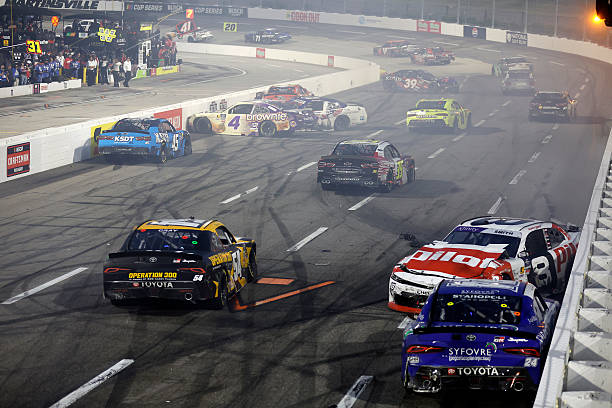
However, the issues have now hit a critical point in the lower series. Specifically from this Martinsville weekend, the Xfinity Series. Somehow, the Craftsman Truck Series put on the best show with the least amount of drama. Instead, the Xfinity Series drivers put it upon themselves to become the headline. More than simply the last lap debacle, the Marine Corps 250 illuminated how modern NASCAR has turned short track racing in anarchy. The big question is what can be done to fix these problems.
Xfinity Series Madness
Saturday’s Xfinity Series race offered more chaos than the last lap. Sure, Sammy Smith’s actions heading into Turn 3 definitely steal a lot of the attention. However, the entire Marine Corps 250 was an event filled with drivers exposing their immaturity and lack of care/talent. Over 40% of the race was run under the yellow flag, totaling 104 laps. While some of those laps can be chalked up to NASCAR’s pedestrian pace between stage breaks, 67 of the caution laps were run after the field took the green flag for the final stage. During the last stage, the average green flag run was a mere 5 laps long. Embarrassing.
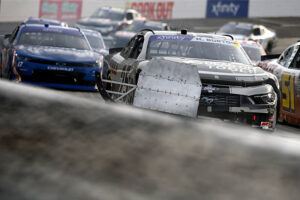
While short track racing always contains elements of bumping and shoving, the Xfinity Series drivers took it too far. Saturday turned into a bleep-show very quickly, especially after a relatively tame first two stages. All of that madness built to the last lap finish. Entering Turn 3 for the final time, Sammy Smith called upon his best Austin Dillon moves and drove through Taylor Gray from the outside lane. Smith did not even have the preferred line to drive through the leader, but he still managed to do it. Had Gray’s car not been there, Smith would have driven head first into the outside wall. That move stacked up the field and allowed Austin Hill to muscle his way on the inside to win the race from fifth.
It would be nice to say Saturday’s race was a one-off, but this has sadly been a recurring issue for the Xfinity Series. Martinsville has been the key track where these shenanigans have unfolded most, but essentially every short track (and road course) features this type of racing. Now, it is one thing to see Sammy Smith torpedo the leader on the last lap. However, the entire final stage featured overly aggressive moves with drivers battling for 15th. That is where it gets ridiculous
No Respect Shown, No Respect Given
Perhaps the most infuriated aspect of Saturday’s racing was the lack of accountability. After that race, does anyone truly believe anything will change for the next short track? If anything, this will only worsen as the year carries to the end of the regular season and playoffs. The drivers were willing to destroy their cars in race seven of the year. Imagine how bad it is going to be when the series returns to Martinsville for the elimination race.
https://twitter.com/bobpockrass/status/1906141096242974947
In postrace race interviews, Sammy Smith justified his actions with the classic response of “if not me, then someone else would do it”. That answer is frustrating for two different reasons. First, justifying an action by saying someone else would is shallow and excuse making. Pair that with a “I don’t want to drive that way” and you fight yourself from rolling your eyes. If Smith (or any driver) does not want to race that way, then do not do it.
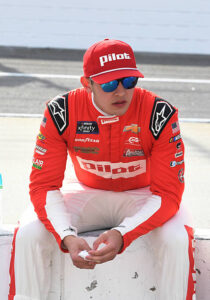
In this scenario, no one on that final lap was going to plow Smith out of the way for second. Taylor Gray did not wreck Smith for the lead. Did Gray move the 8? Of course, but he did not wreck Smith. After Gray moved the 8, Smith was racing for second. When Smith moved the 54, he wrecked the field. Instead of finishing second, Smith winds up 10th and costs his JRM teammate (Justin Allgaier)from pulling out the win as well.
The other reason why Smith’s explanation is frustrating is that he is correct (in a way). There have been too many incidents that prove his point valid. Although Gray did not pull the same stunt, another driver probably would have in that situation. Ty Gibbs did it to his own teammate in 2022. Sheldon Creed and Austin Hill tangled in 2023. This aggression is not uncommon nor is it dying down.
Is There a Solution?
The big question from the Marine Corps 250 is whether there is a solution. Denny Hamlin offered his thoughts on X, stating that NASCAR should move to penalize drivers for this type of racing. NASCAR said they will review Sammy Smith’s actions and potentially offer up a penalty on Tuesday. Jeff Gluck on The Teardown believes an in-race/quick post-race penalty is the way to go. Instead of taking 2-3 days to review actions on track, NASCAR officials should make the “common sense” call and issue a running order penalty before the cars leave pit road.
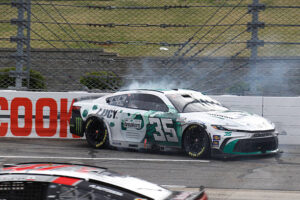
While that seems to be a logical solution, does anyone want NASCAR making more calls? Their record with consistency is always under scrutiny, especially when it comes to disciplining drivers. Already this year, NASCAR became under fire over not suspending Austin Cindric when he right hooked Ty Dillon at COTA. That decision looks worse after Cindric’s questionable actions after his spun Riley Herbst on Sunday. Additionally, last time NASCAR was at Martinsville, it took the officials 28 minutes to decide the fate of William Byron and Christopher Bell after that debacle. Although sensible, NASCAR doing more officiating might not be the way to go.
Solving a NASCAR Made Problem
One of the bigger reasons NASCAR should not be the one corralling these drivers in is the fact they have set up the sport to work this way. NASCAR has a long history of drivers wrecking each other, whether for wins or rivalries. However, the landscape has changed from the previous generations. You can point to a myriad of reasons why drivers today show little respect on the track. Less of the drivers, especially the younger ones, worked on the cars they drove. Hardly any do work on their current cars/trucks. Additionally, the iRacing generation finding more pathways to stock car racing alters their background and experience. It is a lot easier to make mistakes or wreck someone with a virtual car where damage disappears immediately after the race is over.
Those reasons play a part, but arguably the largest factor in today’s new style is the NASCAR format. Championships decided by a playoff system with eliminations. Win and your in/advance to continue succeeding. What NASCAR has told the drivers, teams, sponsors, and fans is that only winning matters. A “good points day” or long-term consistency can be uprooted by winning a single race. That mentality leads to a style of driving that leans into the all-or-nothing approach. Why settle for second when a playoff spot is right there?
When Austin Dillon wiped out Joey Logano and Denny Hamlin to win Richmond last year, the reasoning for it was completely understandable. Especially for Dillon, who is more involved with the operations of his organization, that win represented more than a trophy. Locking a car into the playoffs means more money coming in the door from the final payout. It also allows more race-winning strategies in future events. NASCAR’s effort to make every race “meaningful” with championship consequences brings this result.

Ownership/Sponsorship Stepping In
Sometimes, the solution needs to be outside of the officiating’s control. In other sports, when a player acts foolish or unsportsmanlike, the coach sits them. Especially in the minor leagues or amateur ranks, the leaders of the respective teams handle this stuff internally. Why should NASCAR be different? While NASCAR should step in to handle the egregious actions like Dillon’s last year and maybe Smith’s this weekend, the owners and leadership personnel of the individual organizations should be the voices of reason.
I’ve been really quiet on this over the last few days but it’s clear this is important to fix and also clear that it’s bigger than 1 race weekend.
My 2 cents- The solution needs to come from the car owners not NASCAR. Until the car owners are willing to park their drivers for… https://t.co/JvJw1q4X4A
— Brad Keselowski (@keselowski) March 31, 2025
Brad Keselowski posted his thoughts about this on X, stating that owners should be willing to bench drivers over this type of driving. That would likely send the loudest message to these drivers. While NASCAR can throw the book at these guys, being sat by your own organization would speak greater volumes. NASCAR loses little by suspending or punishing drivers. Sure, teams might appeal or speak out while others complain, but it will not hurt the bottom line much at all. However, teams do have stakes with their drivers and choosing to punish a driver for egregious driving could jeopardize both competitiveness and the pocket book. With actual stakes to consider, the weight of the decision should be more effective.
That is where sponsors factor in here as well. The organizations that fund their selected driver to race Fridays, Saturdays, and/or Sundays should support a team’s decision to sit said driver. For funded drivers, the sponsorship usually is tied to family or close friends. However, that driver still represents their brand. Does a company want a “dirty” driver being their cover athlete? If sponsors started backing these decisions or outright pulling money over on-track actions, that would be a quick way to resolve this.
Some may yearn for more driver altercations to help resolve the driving issues, yet that solution will never be permanent. Although NASCAR could be a bit more hands-off to let frustrations boil over more from time to time, pit road or the garage does not need to devolve into the octagon. Also, what if the guilty driver wins the fight? Getting punched in the face might hurt in the moment, but it may not leave the lasting outcome people want.
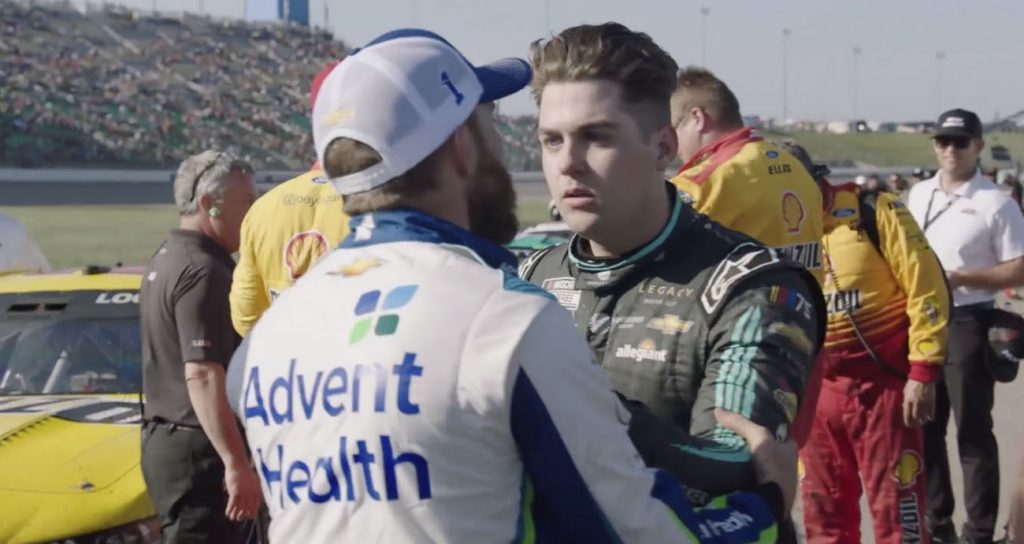
A prime example of this dichotomy is Ross Chastain. After Kansas in 2023, Noah Gragson tried to fight him over an on-track dispute. Chastain won the fight and continued to race his way. What actually made Chastain adjust his style that season? Pressure from Chevrolet via Hendrick Motorsports to Trackhouse Racing, Justin Marks, and Chastain himself.
In NASCAR (and most of life), little makes a more immediate impact than depriving one of opportunities or money. If Saturday is unacceptable, then the response needs to meet the moment. Suspensions and fines might not get the job done, especially in today’s “anything to win” mentality. However, teams can wield a great power here to help deter this racing. The solution could be right there. Will the teams step up to fix it or accept Saturday as the status quo?
Something About Tires
As for the Cook Out 400, the Cup Series entered the spring Martinsville weekend in hopes of replicating last year’s playoff race. Bringing the same tire back for this race, tires should have been a major factor in deciding the race. However, fans were once again left disappointed by a tire-based hope. To be fair, Sunday’s race might have been the best spring Martinsville race in the Gen7 car. However, that bar is so low you would struggle to not trip over it.
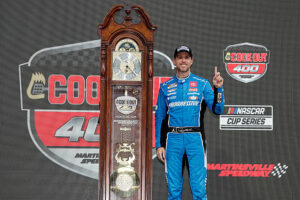
Denny Hamlin dominated the race, especially once he gained the lead in the middle of Stage 2. Leading 274 of the 400 laps, Hamlin sailed to an easy win. Dominant wins are a part of NASCAR. While some may have an issue with limited action for the lead, the main issue lays down the leaderboard. Martinsville never has been a track where drivers can easily move through the field. Track position has been key, but not to this extreme. Perhaps the most damning element of Sunday’s race was the fact that the Top-10 running order did not change over the final 50 laps. Other than Joey Logano and his 40+ lap fresher tires, the Top-10 remained stagnant.
When watching the race, you can see that slower drivers could easily hold up faster cars behind them. For example, Christopher Bell burned off his tires at the start of the final run trying to pass Hamlin for the lead. Bubba Wallace and Chase Elliott were clearly faster at that point. However, Bell managed to hold them off. That should not be the case.
Tires are Short-Term Solutions
Goodyear deserves a lot of praise for what they are doing with their product. NASCAR has leaned on them to help bring more compelling racing to short tracks and Goodyear is delivering. Sunday’s race is not on Goodyear. What is being proven is that the tire is at best a 1-2 race solution. This weekend’s Cook Out 400 followed the same pattern of last year’s Bristol Night Race. High hopes for a tire that performed well in the last race to then be underwhelmed by the racing.

How does this happen? Why does the same tire perform so well one race then follows it up with a dud the next? Some may point to weather conditions, especially considering the difference between fall and spring. That might play into it, but the reason might be simpler than that. After teams experience the tire on track for the first time, they now have a template of what to do. Hours are spent at the race shops figuring out how best to setup the car to run on the tire when returning to that track. Once the element of surprise is out, the teams hone in on what to do to get their cars right.
If this is the case, then tires cannot be NASCAR’s long-term solution to short track racing. Maybe utilizing option tires is the way to go, but that is still diverting from the real issue. Using tires as the scapegoat is a convenient way to hold off on fixing the actual problem: the Gen7 car.
How Long Until NASCAR Accepts Defeat?
NASCAR is in a bit of bind with the Gen7 car. What was supposed to be a cost-saving, short track/road course masterclass has turned into an overly priced, intermediate track savant. The NextGen car has made the racing at every type of track worse except for the traditional intermediate. Short tracks clearly is the most hurt by this car, as the racing at Bristol and Martinsville have been severely underwhelming as a whole. NASCAR tinkered with the car, which did little to fix the issue. Meanwhile, Goodyear is almost to the point where they send out flat tires to make the racing exciting.
Understandably, NASCAR does not want to go and make wholesale changes to the Gen7. That would be too costly (and embarrassing) to do. The organizing body will hold off on that for as long as possible, but the day will arrive where they can no longer ignore the glaring issues. Even an untrained eye can see certain aspects of the car that simply hurt short track racing. If NASCAR wants better short track racing, then the car will need to be redesigned in some grand way. Maybe putting more horsepower under the hood could help, which would be most cost effective than changing the car. However, NASCAR has drawn the line in the sand there. It is an intriguing question to ponder though. Which will happen first: adding more horsepower or updating the Gen7?
Any Martinsville weekend should filled with great action on the track. This weekend though was marred by on-track blemishes. Even the Truck Series race featured some unsavory driving, so that cannot be considered a clean race. NASCAR is facing some short track problems that need to be address. Martinsville, as well as Bristol and Richmond, need to be tracks that thrive on the schedule. Right now, their non-playoff dates are becoming more skippable.


